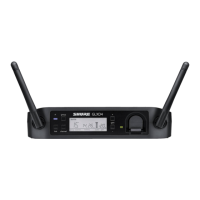Why can't I adjust my Shure Receiver controls?
- SSean SnyderAug 28, 2025
If you see 'LK' on the receiver display of your Shure Receiver when buttons are pressed, the controls are locked. Please refer to the section on Locking and Unlocking Controls.

Why can't I adjust my Shure Receiver controls?
If you see 'LK' on the receiver display of your Shure Receiver when buttons are pressed, the controls are locked. Please refer to the section on Locking and Unlocking Controls.
How to adjust sound levels on Shure Receiver when switching sources?
To adjust sound levels on your Shure Receiver when switching to different sources, adjust the transmitter gain as necessary.
How to fix unsuccessful link between Shure Transmitter and Receiver?
If the transmitter and receiver LEDs flash to indicate that linking started, but the link between your Shure Transmitter and Receiver fails, update both components to firmware version 2.0 or greater. Download the Shure Update Utility application and follow the instructions.
How to resolve distortion on Shure Receiver?
If you are experiencing distortion and the OL indicator appears on the receiver LCD of your Shure Receiver, reduce the transmitter gain.
How to stop RF interference on Shure Receiver?
To minimize RF interference on your Shure Receiver, especially when the receiver screen flashes '-- --', move the system away from other 2.4 GHz sources such as Wi-Fi access points or computers. If using directional antennas, place interference sources behind the antennas to minimize interference. Placing receivers or directional antennas closer to transmitters may also help.
How to fix a Shure Receiver when the LCD screen is off?
If the LCD screen on your Shure Receiver is off, ensure that the AC adapter is securely plugged into the electrical outlet and that the receiver is powered on.
What to do if my Shure Receiver has no sound?
If your Shure Receiver has no sound, check the following: * If the Receiver RF LED is on, verify all sound system connections or adjust gain as needed and ensure the receiver is connected to the mixer/amplifier. * If the Receiver RF LED is off: * Turn on the transmitter. * Make sure the batteries are installed correctly. * Link the transmitter and receiver. * Charge or change the transmitter battery. * If the Receiver LCD screen is off: * Make sure the AC adapter is securely plugged into the electrical outlet. * Make sure the receiver is powered on. * If the Transmitter indicator LED is flashing red, charge or change the transmitter battery. * If the Transmitter is plugged into the charger, disconnect it.
Why is the receiver LCD screen off on my Shure Microphone system?
| Battery Life | Up to 16 hours |
|---|---|
| System Type | Digital Wireless |
| RF Output Power | 10 mW |
| Connector Type | 1/4" |
| Rechargeable Battery | Yes (Li-ion) |
Essential safety guidelines for operating the wireless system and related equipment.
Critical safety information regarding battery use, replacement, and potential hazards.
Lists the parts that come with the system and other available accessories for purchase.
Step-by-step guide for initial system setup and establishing a wireless link.
Identifies and explains the function of all controls and connectors on the GLXD4 receiver.
Describes the status indicators, battery life, and other information displayed on the receiver's LCD screen.
Details the transmitter's power switch, antenna, ports, and status LED behavior.
Instructions for properly positioning headworn and bodypack microphones for optimal audio capture.
Explains how to charge batteries using the receiver bay or external sources and interpret LED charge indicators.
Step-by-step guide for inserting rechargeable batteries into bodypack and handheld transmitters.
Guidance on setting up systems with multiple receivers and configuring combo systems.
Describes the process for manually linking transmitters to receivers and vice versa.
Strategies for overcoming challenges in the 2.4 GHz band, including Wi-Fi coexistence and performance tips.
Tables detailing frequency assignments for different groups and channels, along with latency information.
How to adjust audio gain and lock/unlock system controls to prevent accidental changes.
Features for identifying linked devices and manually choosing system groups and channels.
A guide to diagnosing and resolving common problems encountered with the wireless system.
Instructions for resetting the receiver and transmitter to their original factory configurations.
Detailed technical data including range, audio response, RF sensitivity, and output connection details.
Dimensions, weight, power requirements, and housing materials for the GLXD4 receiver.
Technical details specific to the GLXD1 bodypack transmitter, including its dimensions and connector.
Technical details specific to the GLXD2 handheld transmitter, including its dimensions and weight.
Information on FCC, IC, and European Union certifications and compliance standards.
Guidance for users on RF energy, interference, and best practices for installation.
Explains Shure's intelligent automatic frequency management for seamless audio connections.
Details the smart battery system, charging options, and runtime benefits of GLX-D transmitters.
Features of the GLXD4 Wireless Receiver and GLXD6 Wireless Guitar Pedal Tuner & Receiver.
Features of the GLXD2 Handheld Transmitter and GLXD1 Bodypack Transmitter.
Various handheld microphone options for vocal applications with the GLXD2 transmitter.
Options for guitar, instrument, presenter, and headset applications using the GLXD1 bodypack transmitter.
Lists system options, included components, and technical specifications for GLXD2 and GLXD1 systems.
Covers operating range, frequency band, audio range, power, and battery life for the GLX-D system.